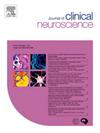Association between gait profile and spinal alignment in patients with adolescent idiopathic scoliosis
IF 1.9
4区 医学
Q3 CLINICAL NEUROLOGY
引用次数: 0
Abstract
This study aimed to investigate the association between gait profile and spinal alignment in adolescent idiopathic scoliosis (AIS). The study group consisted of 80 AIS and 80 healthy controls. All participants underwent radiographic imaging and measured gait analysis. The gait profile included gait speed, step length, stance phase, cadence, single leg support, double legs support, gait asymmetry (GA), and phase coordination index (PCI). The spinal alignment parameters included pelvic tilt (PT), sacral slope (SS), pelvic incidence (PI), thoracic kyphosis (TK), lumbar lordosis (LL), sagittal vertical axis (SVA), and coronal balance (CB). The mean age of the AIS group was 15.1 years, while the control group was 14.6 years. Significant differences were observed between the AIS patients and controls in gait speed, step length, stance phase, cadence, single leg support, double legs support, GA, PT, TK, SVA, and CB. However, no significant differences were found in PCI, SS, PI, and LL (p > 0.05). Additionally, correlation analysis revealed a close relationship between gait profile and spinal alignment parameters. Step length was significantly related to PT, SS, and LL, while GA was correlated with TK in AIS patients. Multiple regression analysis for predictors of step length found that PT and SS accurately predicted step length. First, the AIS group showed significant differences in gait kinematics and spinal alignment compared to the control group. Second, statistically significant correlations were found between gait profile and spinal alignment parameters. Specifically, PT and SS accurately predicted step length, and TK was correlated with GA in AIS patients.
青少年特发性脊柱侧凸患者的步态特征与脊柱排列之间的关系。
本研究旨在探讨青少年特发性脊柱侧弯症(AIS)的步态特征与脊柱排列之间的关系。研究小组由80名特发性脊柱侧弯症患者和80名健康对照者组成。所有参与者均接受了放射成像检查和步态分析测量。步态特征包括步速、步长、步态相位、步幅、单腿支撑、双腿支撑、步态不对称(GA)和相位协调指数(PCI)。脊柱排列参数包括骨盆倾斜(PT)、骶骨斜度(SS)、骨盆内陷(PI)、胸椎后凸(TK)、腰椎前凸(LL)、矢状垂直轴(SVA)和冠状面平衡(CB)。AIS 组的平均年龄为 15.1 岁,而对照组为 14.6 岁。AIS 患者与对照组在步速、步长、步态阶段、步幅、单腿支撑、双腿支撑、GA、PT、TK、SVA 和 CB 方面存在显著差异。但在 PCI、SS、PI 和 LL 方面没有发现明显差异(P > 0.05)。此外,相关分析表明步态轮廓与脊柱排列参数之间存在密切关系。步长与 PT、SS 和 LL 明显相关,而 AIS 患者的 GA 与 TK 相关。步长预测因素的多元回归分析发现,PT 和 SS 能准确预测步长。首先,与对照组相比,AIS 组在步态运动学和脊柱排列方面存在显著差异。其次,步态曲线和脊柱排列参数之间存在统计学意义上的相关性。具体而言,AIS 患者的 PT 和 SS 可准确预测步长,而 TK 与 GA 存在相关性。
本文章由计算机程序翻译,如有差异,请以英文原文为准。
求助全文
约1分钟内获得全文
求助全文
来源期刊

Journal of Clinical Neuroscience
医学-临床神经学
CiteScore
4.50
自引率
0.00%
发文量
402
审稿时长
40 days
期刊介绍:
This International journal, Journal of Clinical Neuroscience, publishes articles on clinical neurosurgery and neurology and the related neurosciences such as neuro-pathology, neuro-radiology, neuro-ophthalmology and neuro-physiology.
The journal has a broad International perspective, and emphasises the advances occurring in Asia, the Pacific Rim region, Europe and North America. The Journal acts as a focus for publication of major clinical and laboratory research, as well as publishing solicited manuscripts on specific subjects from experts, case reports and other information of interest to clinicians working in the clinical neurosciences.
 求助内容:
求助内容: 应助结果提醒方式:
应助结果提醒方式:


